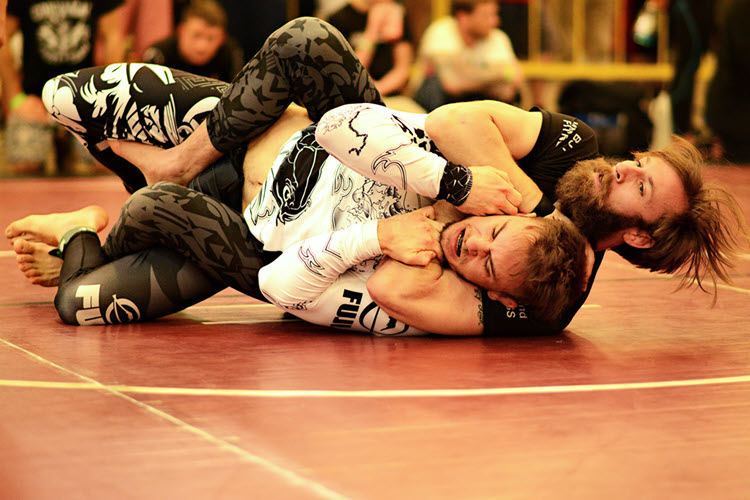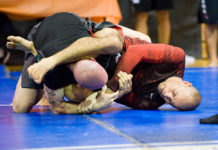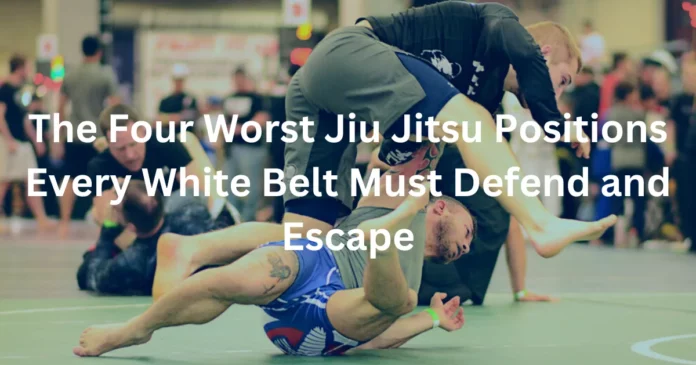Your number one goal as a white belt is to learn how to survive and escape bad Jiu Jitsu positions.
In this article, we will cover the basics of BJJ, including fundamental concepts every white belt must learn and general knowledge such as:
- The significance of defense
- BJJ basic positions
- Key factors and similarities between Gi and No-Gi
At the end, I’ll give you a tip about my favorite BJJ escape instructional.
Now let’s roll!
Fundamental Defenses in Bad Jiu Jitsu Positions
Understanding Brazilian Jiu Jitsu basics gives you the foundation – a base to build your practice upon. Basic Jiu Jitsu will teach you the principles needed to develop your ability. With BJJ fundamentals you will learn to avoid bad positions, gripping methods, proper breathing methods, as well as retaining and passing guard.
There is so much to learn as a whitebelt and focusing on the basics of Jiu-Jitsu will help you learn the core of BJJ – without the fundamentals all the other details are useless. Additionally, if you have not already done so, be sure to equip yourself with the best BJJ equipment, especially when it comes to No Gi BJJ gear.
BJJ Positions & Escapes to Learn as a White Belt
In our BJJ fundamentals curriculum you will learn what to do once your guard has been passed. Below are the BJJ basic positions you will be in and a basic escape.
Side control
Side control is one of the main bad Jiu Jitsu positions you will end up in as a BJJ white belt. In Jiu Jitsu side control, your rolling partner on top is kneeling 90 degrees chest to chest to you leaving little room to breathe. Their arm closest to your legs comes under your armpit known as an ‘underhook’. Their other arm, closest to your head, will be under your neck with their shoulder driving down into your face – this is called ‘crossface’.

Surviving Side Control
As a white belt in Brazilian Jiu-Jitsu it’s difficult to fight your instincts and push into your opponent, exhausting yourself in the process. Stay patient, keep your elbows tight to protect your neck & arms while keeping your legs engaged preventing your opponent from passing to mount. While on the bottom make a slight angle to create space and breathe more efficiently.
Escaping Side Control
In this BJJ escape, use your arm nearest to their head to push your head away and clasp your hands together and push away hard. Use your legs to push off of the ground and drive your hips to the sky. This is known as bridging.
Extend your arms as your hips come back to the ground, push your hips away from your partner – now you know the hip escape or shrimp. You can now bring your top leg to pivot on your foot to square yourself up. Using this method will create enough room to sneak your knee through the gap you have made. If your leg gets stuck in between, you can push off with your shin to create more space to clear your leg and regain guard.
Mount
In BJJ mount your opponent is on top of you over your hips with their legs on either side of your abdomen.

Surviving Mount
It’s important to keep your elbows tight to your sides and hands close together to prevent submissions. Block their hips with your elbows and attempt to frame with an arm against their hip bone, stopping them from climbing their hips closer to your head.
Escaping Mount
A common mount escape in BJJ is the basic bridge and roll technique. Start by bumping them forward with your pelvis to break their posture. Now hug your partner tightly under their arms to gain double underhooks.
Keep your head close to their chest so they can’t pry your head off. At this point inch up using your underhooks and grab onto their shoulders in order to pull yourself up. Now they are lower on your hips, try to overhook an arm.
The next step is to pinch their elbow to your side and bridge towards the arm you have trapped. At the same time, use the opposite underhook to push them in the same direction. Now the position is reversed and you are on top in your opponent’s guard.
Back Control
In Jiu Jitsu back control, one person is behind the other with their legs around the other’s waist bringing the feet in between the inside of the thighs for control (hooks). One arm comes over the head and the other under the armpit – this is known as a seatbelt grip.

Surviving Back Control
In order to survive once your back is taken, you have to defend the hooks and seat belt control. Pull your knees up to your chest, knees to elbows taking the space needed to pass their legs through. Make an X with your arms while keeping both elbows pinned to your sides preventing the underhook. Now use your hands to grab onto a wrist. This makes it more difficult for the person on top to secure seat belt control in BJJ.
Escaping Back Control
To escape back mount in Jiu Jitsu, fight the hands to free yourself of seatbelt control and the hooks your opponents legs created. Fight the hands and strip any hand grips. Make a grip on the wrist, bring your other hand to secure double wrist control and pull the arm down.
Now, swing the arm over to the same side of the other arm, swinging your head under and over the arm. Now that both of their arms are on the same side you can focus on sliding your back and shoulders to the mat. With the mat on your back instead of your opponent you can use your arm to push their leg away, keeping them from turning back into you and pulling you legs out to escape.
Knee on Belly
With knee on belly position in BJJ your partner’s knee is pressing down on your stomach while their other leg is pushing off the mat for added pressure.
Surviving Knee on Belly
In BJJ, surviving the knee on belly requires you to keep good posture with elbows close to your ribs and open hands to fight off choke or grip attempts.
Escaping Knee on Belly
Forward shrimping is a great escape in Jiu-Jitsu if your opponent has the knee-on-belly position. Start by keeping your elbows tight and close to your side so there is no room for their arm to reach over to your far side and make a grip or underhook.
Then turn enough to get your bottom elbow in front of their knee, using your far leg to push off the mat to forward shrimp (turning into them) while using your elbow to push the knee off your body. Keep your core engaged to keep your elbow and knee together.
Now frame with your forearm and knee to push off and turn yourself away from them. Bring your far leg over their arm or under the hip to push and create space and bring your legs back in between.
No Gi vs Gi BJJ Basics
Gi Brazilian Jiu-Jitsu and No Gi Brazilian Jiu-Jitsu share many of the same techniques and positions but implement them differently. The biggest differences are Gi grips and the strategies used. No Gi Jiu-Jitsu has a faster pace due to having fewer options for grips, meaning less stalling and no friction of the Gi making sweat more of a factor.
Gi Jiu-Jitsu has more setups for submissions that require certain grips that cannot be done without the kimono. With that in mind it makes for a more defensively aware and technical BJJ approach.
In No Gi Jiu-Jitsu there is a limited ability to control and fewer submissions available compared to Gi Jiu-Jitsu. So there is an emphasis on underhooks, overhooks, and grips on the neck or joints.
The BJJ basic positions you learn in Gi Jiu-Jitsu will largely be similar to those in No Gi Jiu-Jitsu. The science of Brazilian Jiu-Jitsu is the understanding of our biomechanics, how the body moves with a grasp on why techniques work and when to apply them.
The Best BJJ Escape Instructional
I recommend spending a good amount of time learning to escape mount. The reason is that in a self defense scenario, mount is the worst place to be.
Plus, in competition BJJ you often end up in mount if you lose on the traditional sequence of takedown, guard passing, and side control.
If you fail to escape mount, you are doomed to get submitted. If you don’t escape mount with proper technique, you are liable to get your back taken.
With that said, if you want to fast-track your progress learning mount escapes from an old school master, I recommend checking out the Henry Akins Mount Escape Mastery course.
I have personally worked through the entire course myself as a blue belt, and Henry’s escape style played a major role in my ability to recover position after being mounted in rolls and matches.
Henry Akins is a phenomenal instructor and overall Jiu Jitsu legend, I just wish I had started learning his escapes as a white belt.
Jiu Jitsu Positions Frequently Asked Questions
What are BJJ fundamentals?
BJJ fundamentals are the core principles and basic ability needed in order to utilize your Brazilian Jiu-Jitsu the same as learning footwork would be to a boxer. The fundamentals are learned as a white belt, these are the Jiu-Jitsu basics. For example the BJJ basic positions such as open or closed guard, half guard, side control, mount, back control. In our BJJ fundamental curriculum we teach balance, passing, grip fighting, remaining calm, learning to breathe and how to shrimp. The fundamentals found in basic Jiu-Jitsu will carry you all the way to black belt.
How long does it take to learn basic BJJ?
Your commitment to BJJ will affect how fast you will learn. For example if you train 3 times a week it can take as little as 6 months to learn the BJJ basics. But everyone learns at a different pace, it varies with every individual. On average a year is much more realistic as you are essentially learning to crawl in BJJ. Unfortunately there are no shortcuts. The more you train and drill the technique the faster you will learn the basics of BJJ.
Why are Jiu-Jitsu basics so important?
The basics of Jiu-Jitsu is the beginning to more advanced techniques. Many newer white belts are sporadic, kicking and punching in inefficient ways like swimming against the current. If you learn the proper Brazilian jiu-jitsu basics, movements become easier and less forced. The basics are the foundation of every movement you will make, building the skills to survive and more importantly flourish on the mats.
BJJ Basics: the bottom line
The BJJ fundamental concepts will give you the ability to defend yourself in the martial art. Brazilian Jiu-Jitsu basics will develop your skill and refine your technique. The way to your blue belt lies in the fundamentals you need to defend and avoid the worst positions in BJJ.






